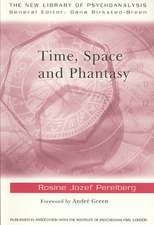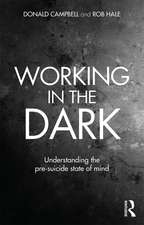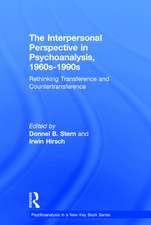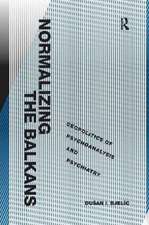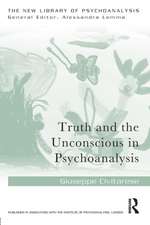Understanding Mental Objects: The New Library of Psychoanalysis
Autor Meir Perlowen Limba Engleză Paperback – 17 aug 1995
The book begins with an historical survey of how mental objects have been understood in the various 'schools' of psychoanalysis as they have developed. These include Freud and his associates, the object-relations approaches of Klein, Fairbairn and Bion, orientations derived from ego psychology such as those of Schafer and Kernberg, and the self orientation of Winnicott and Kohut. In Part Two the author discusses the conceptual and clinical issues involved in the major differences between the concepts. Finally, in Part Three he delineates three basic meanings of the concepts of mental objects as they have emerged in the literature and shows how they are related to ongoing issues in contemporary psychoanalysis.
This long overdue clarification of a complex area, with its wide ranging and imaginative grasp of the different theories about objects, will be an invaluable reference for all psychoanalysts and psychologists.
Din seria The New Library of Psychoanalysis
- 5%
 Preț: 293.44 lei
Preț: 293.44 lei - 5%
 Preț: 264.13 lei
Preț: 264.13 lei - 5%
 Preț: 233.66 lei
Preț: 233.66 lei - 5%
 Preț: 295.02 lei
Preț: 295.02 lei - 5%
 Preț: 298.13 lei
Preț: 298.13 lei - 5%
 Preț: 762.86 lei
Preț: 762.86 lei - 5%
 Preț: 294.02 lei
Preț: 294.02 lei - 5%
 Preț: 234.37 lei
Preț: 234.37 lei - 5%
 Preț: 349.43 lei
Preț: 349.43 lei - 5%
 Preț: 273.05 lei
Preț: 273.05 lei -
 Preț: 295.41 lei
Preț: 295.41 lei - 5%
 Preț: 289.20 lei
Preț: 289.20 lei - 5%
 Preț: 253.71 lei
Preț: 253.71 lei - 5%
 Preț: 373.84 lei
Preț: 373.84 lei - 5%
 Preț: 259.64 lei
Preț: 259.64 lei - 5%
 Preț: 218.59 lei
Preț: 218.59 lei - 5%
 Preț: 233.60 lei
Preț: 233.60 lei - 5%
 Preț: 233.06 lei
Preț: 233.06 lei - 5%
 Preț: 235.05 lei
Preț: 235.05 lei - 5%
 Preț: 295.41 lei
Preț: 295.41 lei -
 Preț: 309.79 lei
Preț: 309.79 lei -
 Preț: 294.24 lei
Preț: 294.24 lei - 5%
 Preț: 331.66 lei
Preț: 331.66 lei - 5%
 Preț: 282.41 lei
Preț: 282.41 lei - 5%
 Preț: 294.71 lei
Preț: 294.71 lei - 5%
 Preț: 287.55 lei
Preț: 287.55 lei - 5%
 Preț: 280.60 lei
Preț: 280.60 lei -
 Preț: 336.85 lei
Preț: 336.85 lei - 5%
 Preț: 231.83 lei
Preț: 231.83 lei - 5%
 Preț: 316.86 lei
Preț: 316.86 lei -
 Preț: 347.68 lei
Preț: 347.68 lei - 5%
 Preț: 333.70 lei
Preț: 333.70 lei - 5%
 Preț: 259.78 lei
Preț: 259.78 lei - 5%
 Preț: 219.54 lei
Preț: 219.54 lei - 5%
 Preț: 250.75 lei
Preț: 250.75 lei - 5%
 Preț: 266.39 lei
Preț: 266.39 lei - 5%
 Preț: 344.75 lei
Preț: 344.75 lei - 5%
 Preț: 295.21 lei
Preț: 295.21 lei - 5%
 Preț: 287.95 lei
Preț: 287.95 lei - 21%
 Preț: 811.99 lei
Preț: 811.99 lei - 19%
 Preț: 246.34 lei
Preț: 246.34 lei - 5%
 Preț: 362.47 lei
Preț: 362.47 lei - 5%
 Preț: 367.79 lei
Preț: 367.79 lei - 11%
 Preț: 278.48 lei
Preț: 278.48 lei - 5%
 Preț: 365.37 lei
Preț: 365.37 lei - 5%
 Preț: 363.52 lei
Preț: 363.52 lei - 5%
 Preț: 382.02 lei
Preț: 382.02 lei - 5%
 Preț: 377.07 lei
Preț: 377.07 lei - 5%
 Preț: 379.20 lei
Preț: 379.20 lei
Preț: 245.08 lei
Preț vechi: 310.37 lei
-21% Nou
Puncte Express: 368
Preț estimativ în valută:
46.91€ • 50.97$ • 39.43£
46.91€ • 50.97$ • 39.43£
Carte tipărită la comandă
Livrare economică 21 aprilie-05 mai
Preluare comenzi: 021 569.72.76
Specificații
ISBN-13: 9780415121798
ISBN-10: 0415121795
Pagini: 224
Dimensiuni: 156 x 234 x 17 mm
Greutate: 0.35 kg
Ediția:1
Editura: Routledge
Colecția Routledge
Seria The New Library of Psychoanalysis
Locul publicării:Oxford, United Kingdom
ISBN-10: 0415121795
Pagini: 224
Dimensiuni: 156 x 234 x 17 mm
Greutate: 0.35 kg
Ediția:1
Editura: Routledge
Colecția Routledge
Seria The New Library of Psychoanalysis
Locul publicării:Oxford, United Kingdom
Public țintă
Professional and Professional Practice & DevelopmentCuprins
Preface. Introduction. Part One: Historical Survey. Freud and his Associates. Object-related Orientations. Orientations in Ego Psychology. Self Orientations. Part Two: Major Theoretical Issues. Origins of the Mental Object - internal or External. Status of the Mental Object - Experiential or Non-experiential. The Mental Object and Motivation. The Mental Object as a Development Capacity. The Position of the Mental Object Vis-a-vis the Self. Responsibility - The Clinical Issue. Part Three: A Conceptual Analysis. Mental Objects as Representations (Or Schemas). Mental Objects as Phantasies. Mental Objects as Developmental Capacities. Conclusion. Notes. Bibliography. Index.
Recenzii
"... it a reliable and illuminating guide through thickets of psychoanalytic metapsychology ..." - Psychoanalytic Psychotherapy
"Readers will find this book's economy and clarity commendable. The issues raised have stimulated much thought in this reader about theory and practice and this must, I think, mean that the writer has succeeded in his objective." - International Journal of Psychoanalysis
"... there is little doubt that this study represents a major contribution to the field." - Joseph Sandler, Late Emeritus Professor of Psychoanalysis, University College London, UK
"...a reliable and illuminating guide through the thickets of psychoanalytic metapsychology." - Susan Budd, British Journal of Psychotherapy
"Readers will find this book's economy and clarity commendable. The issues raised have stimulated much thought in this reader about theory and practice and this must, I think, mean that the writer has succeeded in his objective." - International Journal of Psychoanalysis
"... there is little doubt that this study represents a major contribution to the field." - Joseph Sandler, Late Emeritus Professor of Psychoanalysis, University College London, UK
"...a reliable and illuminating guide through the thickets of psychoanalytic metapsychology." - Susan Budd, British Journal of Psychotherapy
Notă biografică
Meir Perlow Ph.D., is Senior Clinical Psychologist at Eitanim Psychiatric Hospital, Jerusalem. He was formerly a lecturer in psychoanalytic theory at the Hebrew University, Jerusalem, and now conducts a variety of seminars on psychoanalytic subjects.
Descriere
The book begins with an historical survey of how mental objects have been understood in the various 'schools' of psychoanalysis as they have developed. These include Freud and his associates, the object-relations approaches of Klein, Fairbairn and Bion, orientations derived from ego psychology such as those of Schafer and Kernberg, and the self orientation of Winnicott and Kohut. In Part Two the author discusses the conceptual and clinical issues involved in the major differences between the concepts. Finally, in Part Three he delineates three basic meanings of the concepts of mental objects as they have emerged in the literature and shows how they are related to ongoing issues in contemporary psychoanalysis.
This long overdue clarification of a complex area, with its wide ranging and imaginative grasp of the different theories about objects, will be an invaluable reference for all psychoanalysts and psychologists.





